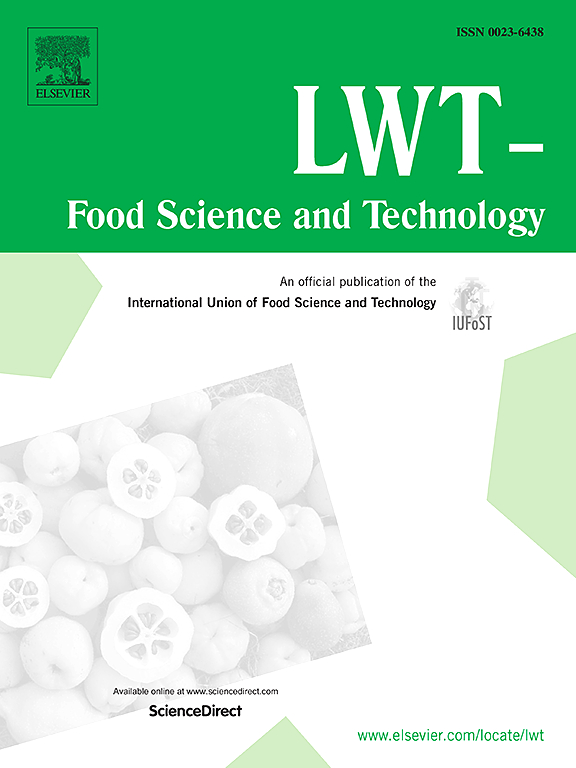Effect of combined low-temperature plasma pretreatment and modified atmosphere packaging on the quality characteristics and microbial community of sous vide Solenocera crassicornis
IF 6.6
1区 农林科学
Q1 FOOD SCIENCE & TECHNOLOGY
引用次数: 0
Abstract
The quality changes of red shrimp (Solenocera crassicornis) muscles during 30 d of refrigeration at 4 °C were compared by evaluating physicochemical properties and microbial diversity. The peeled (1) and shell-on (2) shrimp were grouped by three processing methods: VLS1 and VLS2 (vacuum packaging (VP), low-temperature plasma (LTP), then sous vide (SV)), VSL1 and VSL2 (VP, SV, then LTP), and MLS1 and MLS2 (modified atmosphere packaging (MAP), LTP, then SV). During prolonged chilled storage, the b∗ values, pH, cooking loss (CL), total viable count (TVC), and TVBN in peeled and shell-on shrimp muscles decreased, and the L∗ values, a∗ values, elasticity, water-holding capacity (WHC), and moisture content (MC) increased, while shearing force and chewiness initially climbed and then decreased. Among the three methods, MLS best preserved shrimp quality. Furthermore, High-throughput sequencing (HTS) showed decreased microbial richness and diversity in both peeled and shell-on shrimp with longer chilled storage. Proteobacteria and Firmicutes were the dominant phyla, with Pseudomonas and Achromobacter as the main genera in both muscle tissues. Moreover, correlation analysis showed that the growth of Pseudomonas, Psychrobacter, and Carboxylicivirga was closely linked to various physicochemical factors. This study helps understand red shrimp quality deterioration during refrigeration and supports new preservation methods.

低温等离子体预处理与气调包装相结合对真空蒸熟天牛品质特性及微生物群落的影响
通过理化性质和微生物多样性的评价,比较了4°C冷藏30 d红虾肌肉的质量变化。将去皮对虾(1)和去壳对虾(2)按3种加工方法进行分组:VLS1和VLS2(真空包装(VP)、低温等离子包装(LTP)、真空真空包装(SV)、VSL1和VSL2 (VP、SV、LTP)、MLS1和MLS2(气调包装(MAP)、LTP、SV)。延长冷藏时间后,去皮虾和去壳虾肌肉的b∗值、pH、蒸煮损失(CL)、总活菌数(TVC)和TVBN降低,L∗值、a∗值、弹性、持水能力(WHC)和含水量(MC)增加,剪切力和耐嚼性先升高后降低。在三种方法中,MLS保鲜法保鲜虾的质量最好。此外,高通量测序(HTS)结果显示,冷藏时间较长的去皮虾和去壳虾的微生物丰富度和多样性均有所下降。变形菌门和厚壁菌门为优势门,假单胞菌门和无色杆菌门为主要属。此外,相关分析表明,假单胞菌、冷杆菌和羧酸菌的生长与各种理化因素密切相关。这项研究有助于了解红虾在冷藏过程中的品质恶化,并为新的保存方法提供支持。
本文章由计算机程序翻译,如有差异,请以英文原文为准。
求助全文
约1分钟内获得全文
求助全文
来源期刊

LWT - Food Science and Technology
工程技术-食品科技
CiteScore
11.80
自引率
6.70%
发文量
1724
审稿时长
65 days
期刊介绍:
LWT - Food Science and Technology is an international journal that publishes innovative papers in the fields of food chemistry, biochemistry, microbiology, technology and nutrition. The work described should be innovative either in the approach or in the methods used. The significance of the results either for the science community or for the food industry must also be specified. Contributions written in English are welcomed in the form of review articles, short reviews, research papers, and research notes. Papers featuring animal trials and cell cultures are outside the scope of the journal and will not be considered for publication.
 求助内容:
求助内容: 应助结果提醒方式:
应助结果提醒方式:


